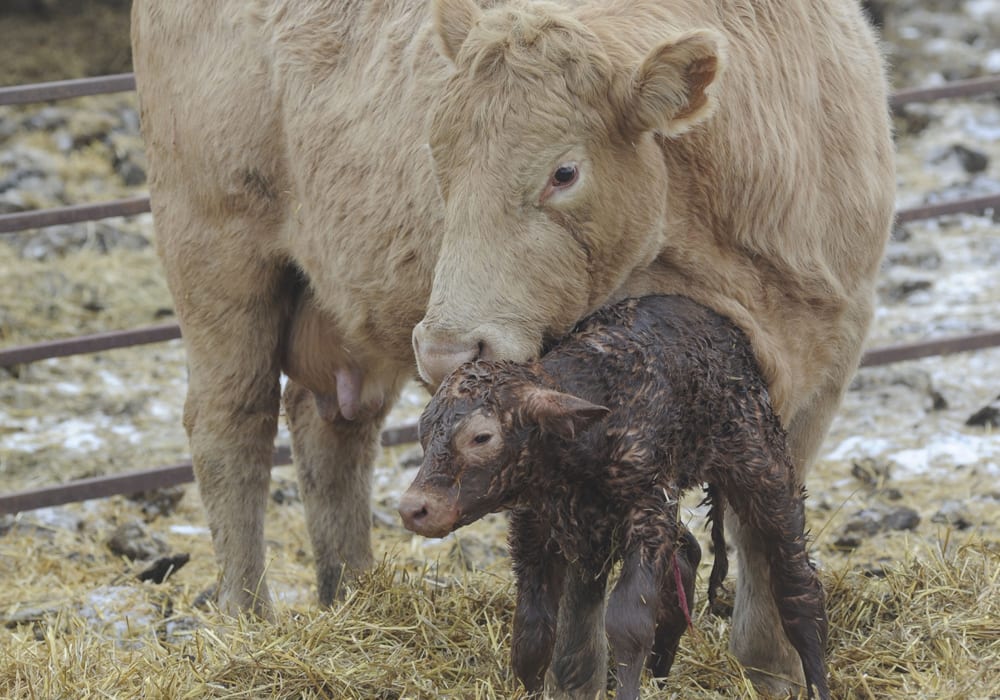A diverse amount of bacterial DNA has been found to exist in the calf’s intestine right at the moment of birth
Are newborn calves born without evidence of any bacteria? One might think so, given the assumed sterile nature of its dam’s uterus. But, according to researchers at the University of Helsinki, Finland, a diverse amount of bacterial DNA has been found to exist in the calf’s intestine right at the moment of birth.
“We are researching healthy pregnancies,” said Mikael Niku, an instructor with the Faculty of Veterinary Medicine. “The healthy uterus has been thought to be devoid of microbes in any mammal (and) the intestine of a healthy newborn has been thought to receive first bacteria only after birth.”
Read Also

Farming Smarter receives financial boost from Alberta government for potato research
Farming Smarter near Lethbridge got a boost to its research equipment, thanks to the Alberta government’s increase in funding for research associations.
There can be considerable bacteria and viruses that are able to penetrate the placenta in cases of uterine infections, but conventional thinking has been that microbial colonization doesn’t begin until after birth. Research has shown the presence of microbial DNA but whether this is live intestinal bacteria is still an open question.
“Our published research shows that there is microbial DNA,” said Niku. “This could mean live microbes, or it could mean microbial fragments, perhaps provided by the dam’s immune system. We are now studying this by doing bacterial culture from newborn rectal samples and slaughterhouse fetuses. It is a challenging topic to study, because the potential numbers of fetal bacteria are very small, and the outside world is full of them, so the samples are easily contaminated. Also, the specialized intestinal bacteria are very difficult to culture as many of them do not tolerate oxygen and require special nutrients.”
Niku said that the bovine immune system is not fully functional at birth and needs colostrum antibodies. But their research, as well as data from other studies, indicates that the fetal immune system in large mammals is more capable than previously thought.
“If there are live bacteria in the fetus, the numbers are very low. Either the fetus is able to strictly control them or there are no live, proliferating bacteria.”
The profile of the DNA bacterial species showed that not all of them were typical bovine intestinal species. In general, he said, the newborn microbial profile was more similar to the adult cow oral microbiota than the adult’s fecal microbiota.
“So, we can only say that the newborn microbiota was more similar to the cow oral microbiota than to the cow fecal microbiota but perhaps rumen or small intestine would be even closer,” said Niku. “In ruminants, the oral microbiota resembles the rumen microbiota. The fecal microbiota is actually quite different from what lives deeper inside the intestine. Nobody knows how the microbial material goes from the mother to the fetus.”
Samples were taken from calves at the moment of birth by researchers at the university’s Vikki Research Farm. They made sure the cows did not lick their calves before getting samples.
Niku said that the composition of the intestinal microbiota changes dramatically during the first day after birth. Then, during the first week, it starts to resemble the adult intestinal microbiota, with typical anaerobic intestinal microbes. The diet makes a difference, so the microbiota in a milk-consuming calf is still different from adults. The newborn calves need the microbes because they are required for the proper function of the intestine and rumen. Yet, at the same time, the calf must be protected from dangerous pathogens.
“This happens as an interplay between the microbes, the calf’s own immune system, the antibodies it receives in colostrum, and other components of the milk which promote the growth of beneficial microbes. This way the gut microbiota and the immune system grow together and learn to know each other. It is a fascinating process.”
Intestinal microbiota is immensely diverse and Niku said that only recently have methods been developed to fully investigate it and identify not only the microbes themselves but their function.
He said it is possible that the dam trains the developing fetal immune system by displaying her microbiota to it. They could be live microbes or microbial components processed by her immune system. Either way, he said, microbes are needed before birth.
“Cattle make most of their antibody-producing cells in the intestine,” he said. “They also have a much smaller number of antibody genes in their genome. Therefore, they must use tricks to generate a large enough variety of antibodies to combat all the different pathogens. They are doing this by intentionally mutating the antibody genes. This usually requires the presence of microbes. We have shown that in cattle this starts in the fetus. We are now trying to find out if this happens as a response to microbes provided by the dam.”
Ongoing studies are looking at the relationship between the dam, the feed the cow is receiving, the milk diet, and the success of microbes in the calves. Similar studies are being conducted on newborn foals and piglets.
The research was published in Scientific Reports.

















